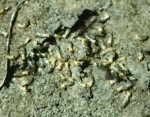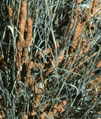
Click On Picture for Larger Image
Desert Termites
Author: Ray Bowers
 Click On Picture for Larger Image |
Species: Gnathamitermess perplexus |
Description:
Desert termites are from 6 to 15mm (0.25 to 0.5 in ) long social insects. Termites are ant like in appearance, but have a broad connection between the thorax and the abdomen, not constricted like ants. The head has a small pore on top that produces secretions used in making dirt tubes. The antennae are straight or slightly curved and threadlike in appearance. Other then these characteristics, the different castes vary In their appearance. The reproductive castes have dark colored bodies and they are the only caste that has wings. The four wings are of equal length and width, but the wings are quickly lost after mating. The workers have pale yellow to white bodies and chewing mouthparts. The soldier caste has enlarged head and large straight mouthparts that are incurved at the tip.
Geographic range:
Termites are found worldwide, but in the United States they are found in the Southwest.
| Habitat: Desert termites form large subterranean colonies, and can be found under rock, wood, or “cow chips.” They will often construct earthen tubes over wood and vegetation. |
 Click On Picture for Larger Image |
Food Web:
Termites feed on cellulose found in plant material. The termites chew the plant material, but in desert termites bacteria that live in the termite's digestive tract digest the cellulose. If the bacteria are not present the termites will feed, but die of starvation. Some types of termites have flagellated protzoans instead of bacteria. Termites play and important role in the environment by breaking down dead plant material. This is especially important in a dry environment like the Chihauhaun Desert . The termites are eaten by a variety of insect eating predators.
Reproduction and Development:
Only the reproductive caste mates, and after mating the queen begins to lay eggs. At first the queen and hatched nymphs take care of the eggs. Later the worker caste will take over this task. Termites undergo simple or incomplete metamorphosis. The nymphs have the potential to develop into any of the castes, but chemicals secreted by the reproductive and soldier castes determine how the nymphs will develop.
Behavior:
In termite societies the queen lays the eggs, but all of the work such as building the colony, gathering food, and taking care of the young is done by the worker caste. The role of the soldier caste as the name implies is to defend the colony. Termites groom each other. Termites will feed on cast skin, feces and dead individuals in the colony, and this allows the digestive bacteria to be passed from generation to generation.
Ecosystem roles:
Termites are major decomposers of plant material in the Chihauhaun Desert . Since cellulose can not be digested by most organisms termites convert this material into termite bodies that are digestible by a variety of insect predators. Termite tunnels aerate the soil, and provides a path for water infiltration.
Taxonomy:
Kingdom: Animalia
Phylum: Arthropoda
Subphylum: Atelocerata
Class: Hexapoda
Order: Isoptera
Family: Termitidae
Genus: Gnathamitermed
Species: Gnathamitermess perplexus
References:
Borror, Donald J. and Richard E. White. 1970. A Field Guide to the Insects of America North of Mexico. Boston : Houghton Mifflin Co.
Borror, Donald J., Charles A. Triplehorn, and Norman F. Johnson. 1989. An Introduction to the Study of Insects. Philadelphia: W. B. Saunders Co.
Bland, Roger G and H. E. Jaques.1978. How to Know Insects. Dubuque , Iowa : Wm. C. Brown Co.
Larson, Peggy and Lane Larson. 1977. The Deserts of the Southwest. San Francisco : Sierra Club Books.
MacMahon. James A.1985. Deserts. New York : Alfred A Knopf, Inc.
Werner, Floyd and Carl Olson. 1994. Insects of the Southwest. Fisher Books, LLC.